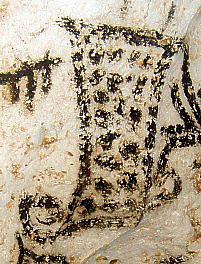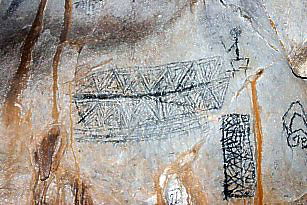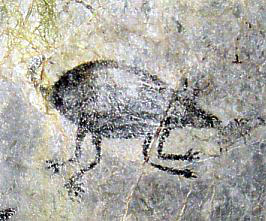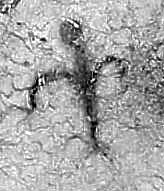Dear Artist,
I’m laptopping you from a cave on the northern coast of the Dominican Republic. By flashlight I’m scanning drawings done up to several hundred years ago by the Taino Indians. Shredded-end sticks dipped into powdered charcoal mixed with animal fat or bat droppings were the preferred media. Other drawings are done with white chalk or red clay.

Some of the caves, like Guacara Sanabe, Jose Maria, and Las Maravillas, have vast panels of drawings, all crowded together. More images below…
There are drawings of food — corn, birds, fish, frogs, turtles, insects, iguanas, and sea mammals, as well as of dogs, which were the Taino’s pets and companions for hunting. There are drawings of stone graters, and of the woven tube the women use to extract the poisonous liquid from yucca to make bread called “casabe.” There are hunting and fishing scenes, pictures related to childbirth and reproduction, pictures of their headmen, six-fingered gods, spiritual leaders, ritual masks, sick people, babies, and their creator spirits as well as the spirits of the wind, rain, and sun.
Aromatic smoke from tiny fires adds mystique to the scene. A shaman is conducting special rituals. He’s praying that the harvest will be good, fishing will get better, the sick will be well, babies will be born without problems, and the soft breezes will not turn into a hurricane. Designated artists step forward and draw while the shaman is speaking. I hear waves of chanting from the darker corners of the cave. Wide-eyed children are perfectly well-behaved. Many of these drawings going up before us are faces that represent the Taino soul — many of them similar to the modern “happy face.” There’s a feeling of excitement and anticipation as art is performed.
The Tainos distinguish between the living world and the spiritual world — the entrances to caves are the portals. Caves are centres of spiritual training — religious classrooms with walls as blackboards. More caves with pictographs are on this island (Hispaniola) than on all others in the Caribbean. Some caves have as many as 500 drawings. This place has a magic that is as tangible as the great cathedrals of Europe — a living presence that quickens history. I shut my laptop — it makes a mysterious beep. When I look around, everyone has suddenly left and only the art remains.
Best regards,
Robert
PS: “Caves were special places, neither here nor there, a place where humans and zemies could meet and come to agreements that would benefit both worlds.” (Dr. Lynne Guitar, Director, Caribbean Amerindian Center)
Esoterica: Artists of today are often supported and honoured as workers of magic. They are considered to be individuals with unique powers, bridging the gulf between what is and what could be. To me, these cave drawings represent the seeds of human imagery — a time-capsule of a society’s collective unconscious. Curiously, one of the drawings is of the sail of a Spanish galleon. Does this drawing announce the beginning of the end, of pestilence, disease, pillage, slavery, war — and the eventual extinction of an artful race?
Taino Indians Artwork

The “Guardian” from Cueva Peñon Gordo. The pictographs in this cave are unusual because they are in white, not black. This guardian is unusual too, for he has eyes in his hands as well as in his head. Note the “happy face” to the right.
The pictographs above represent the Taínos’ daily food: a yucca grater for making casabe bread, the cibucanes needed to squeeze the poisonous juice from bitter yucca to make casabe, an hutia (now nearly extinct), maize/corn, sea turtles (though it was forbidden to eat fresh-water turtles because of their connection with the creation of the earth).
Taíno ABCs — a book by Dr. Lynne Guitar
Womb of introspection
by Helena Tiainen, Berkeley, CA, USA
Caves fascinate because they are literally entrances into the earth. I think subconsciously they remind all humans of the experience of entering our own inner selves. And all of us experience our own selves in a way that nobody else experiences us. We experience ourselves inwardly whereas, generally, others experience us outwardly. Often inner experiences are affiliated with silence, intuition, dreams and the mystical aspects of life. A cave as an entrance into mother earth has always provided shelter to humans and animals alike. It naturally calls for contemplation and offers sort of a womb of introspection. I think the artists that drew on the walls of the caves wanted to reveal something about their own inner experiences in the outside world. They spoke their sacred without words.
Six fingered slip-up
by Gene Black, Anniston, AL, USA
What surprises me among the cave drawings is the six fingered gods. In the last year I began to carve rubber stamps for use in my art. One such stamp shows a hand. I suppose that I was in a state of artistic transcendence when I carved it. The hand has six fingers. This was not planned or thought of, in fact, I didn’t even realize it until a friend asked why the extra finger. I had no answer for her. Perhaps I was finding a deep connection to the Taino.
(RG note) Thanks, Gene. The Taino determined the arrival of a new god by the birth of a six-fingered child, and he or she became god — needless to say a very rare occurrence.
Cave dogs
by Rondi Lightmark, Vashon, WA, USA
I was struck by the round staring eyes and open mouth of the shaman, off in his trance in one of the Taino images. And then, over in the corner on the right, a face with a big smile. I was also delighted to read that the Taino had dogs in their lives. Branny (left) and Jimmy (right) are using a cave constructed on KVI beach on Vashon Island, WA. Driftwood art on our beaches is a record of play, of laughter, whimsey, and sharing. It appears and disappears with the seasons and the tides, but is always renewed by some nameless individual or group who’ve come to the boundary between the land and the sea.
Widespread influence of Taino art
by Eli Marrero, Puerto Rico
I’m glad to read this letter and to know that you are in the Dominican Republic. I’m in Puerto Rico the next island over and whenever I get the chance I visit the ceremonial archeological site in Utuado. There are hundreds of large stones with large carvings on them. The influence of the Taino art is evident on our island — you can buy it from local artisans that make instruments, paintings and ceramics. In Puerto Rico even the local food still has some roots in the Taino and Hispanic roots. In Puerto Rico we have a large community of artists. San Juan is great too because there are lots of galleries and restaurants.
Less is more in Taino caves
by Cora Jane Glasser, New York City, NY, USA
If you look at some of the Taino paintings (Wall Climbing, for example) you see the other side of the Peak Shift coin, “under-doing.” It is the other end of the spectrum of exaggeration, just as, if not more, powerful. Instead of covering up reality with layers of muscle, it strips it down to an understandable and comfortable essence. It is an aspect of primitive art that is harder for modern man to achieve. Less is more.
Images for universal communication
by Linda Walker, Bemidji, MN, USA
Images seem to have always been a favorite and universal way of communicating. When traveling to places as Africa or Far East one of the tools you are given is a brochure that has all of the symbols for important amenities drawn out so you have only to point to be understood. As great as art is for communication, it so no wonder it leaves us in awe of how well the ancient peoples used it for what was important to them. We can only speculate how spiritual the meanings but even if they were used for every day offerings it doesn’t diminish the impact. It shows the importance of sketching or painting while traveling, the camera is a wonderful tool but is not as emotionally responsive as pen or paint.
Modern day cave person
by Paol, Australia
On the subject of cave painting, I did a series of work as a cave man of the 21st Century. I believe what I draw in these paintings will become a legacy of my time. One of the favorite paintings in this series has been “The invention of the Bank” — the principle being that a bank will always cost you an arm and a leg.
Not night, and not ignorance
by Adam Cope, Lanquais, Dordogne, France
Why this feeling of deep mystery upon entering a cavern, the dark spaces beneath the earth? In the words of John Berger talking about Chauvet Grotte which was inhabited and decorated circa 35,000 B.C.: “The animals on the walls are back in the darkness from which they came and in which they have resided for so long. We have no word for this darkness, this darkness which is very closely connected with light. It is not night — and it is not ignorance. Maybe from time to time we all cross into this darkness and see everything that we can distinguish from nothing. Maybe it is the interior from which everything came.”
Casabe, the bread of life
by Manuela Valenti, MI, USA
I enjoyed very much reading this letter, especially because it brings back memories from my birth land Venezuela. It is true the casabe is made with yuca, but not with the yuca you will find at your grocery store these days, that one, the one you boil is considered the “sweet yuca” the yuca used to make the casabe is commonly known as “Yuca Amarga” (sour yuca) highly toxic. The plant looks exactly the same, and the root is very similar yet different enough. The levels of toxic juices are certainly not the same, While the sweet yuca if boiled looses all its toxic juices becoming safe to eat, the sour yuca won’t lose its poison boiling it and it won’t get soft no matter how much boiling, instead a different process, not kitchen friendly, needs to be followed for human consumption to transformed it in casabe. The process has been conceived in South America by the Indians of the Amazon and is also documented on many caves around the region.
The casabe I ate in Venezuela is considered a bread, and many around the country won’t have their daily meals without it. On every part of Venezuela is eaten in a very particular way, for example, in the South East specifically in the Monagas State is eaten during lunch time with a very watery black coffee, where the casabe is deeded into to make it more soft, as the casabe is a really hard extra large cookie, and will accompany any meal, from pasta to beef. By itself it has no taste, yet it is rich in fiber and minerals.
Ingrained nature of colour
by Jen Lacoste, South Africa
A friend of mine once said that my yearnings for home were due to the “colours being right for me in Africa” The more I thought this over, the more I realised that he couldn’t have been more right! For the writers and the painters among us, our work comes partially from memory… and when the memory recall that we invoke in order to work is so hopelessly at odds with the place we are in, creativity is seriously stifled.
Colour is a strange phenomenon, and an important one in one’s sense of identity. In considering that England and Europe have brought forth some big names in the art world, I find it extraordinarily odd that their works seem to have such universal appeal when they are so obviously localised in content and hue. Perhaps one reason why the most successful of the big names are the Impressionists, is because they were telling the world what their own minds wanted to see, and not that which actually was… In other words, what one might dream of finding in that part of the world. Perhaps colour, what the individual expects from it, and how he approaches the use of it, is an ingrained “thing,” very much like the knowledge of the laws of one’s own land…
Art to be learned
by Barbara Callow, Brentwood Bay, BC,Canada
With regard to the awe and respect that creative artists are given for the “special” gifts that they possess, I remember that I answered, when asked, “How can you do that?” with “Anyone can learn. All you have to do is to want to, but it takes time.” Now I see that anyone can learn draughtsmanship, colour theory and composition even if it may take many years to understand and perfect these skills, but one must be born or inherit the creative gene, (the Art Spirit, so to speak). It has to do with how you see and feel about your world, whether it’s your exterior or interior mental environment. Only then you may create truly beautiful or meaningful paintings. That, I believe is the difference and what we keep striving for.
Males more brash and peak shifty?
by Peter Trent, Hawkesbury, ON, Canada
I noticed that in the recent responses to Peak Shift there were fourteen female and three males represented. Is it that the females among us appear to more attuned to the subtleties and nuances of, particularly in this instance, coloration than are the males? Would this imply that males, speaking in generalities, are more prone to brash and loud colors?
(RG note) Thanks, Peter. Maybe you’re on to something. Our editors are very aware that it is important to balance response material in all ways — and I would also hope that responses are chosen for the quality of the idea — and nothing else. Often we are confronted with a problem in that many people may write with more or less the same idea. There is no simple way to choose from these, but it can be the earliest, best expressed, or as encouragement to a new correspondent, but I can assure you that our decision is never based on sex. While I have your attention, I’ll say that contrarian views are always appreciated and very often published.
Looking beyond our memes
by Lynda Lehmann, NY, USA
Looking beyond our memes is a good way for an artist to kick-start his/her personal artistic growth. Recognizing patterns in culture and evolution is also important for general emotional, intellectual, and spiritual perspective. Recognizing and respecting diversity in all its forms is, to me, the bedrock of being a growing, aware, and civilized person. Ironically, recognizing the inherent traits and trends of various cultures may encourage some people to fall into the refrain: “That’s just how it is. Everything must be this way.” I would hope to guard against this kind of fatalistic and reactive thinking. In order to make change, transform ourselves or the world in any large or small way, we need to observe “what is” while believing in the potential for “what isn’t.”
Appreciation of others’ memes
by Jayson Phillips, Garland, TX, USA
Does our cultural meme for “realism” in art see it as less legitimate than so called “high art”? Realism seems to be valued only in art over a hundred years old. Is the “vacuum cleaners under glass” and “sliced shark in formaldehyde” or any art produced in the last 20 years that’s commanding huge prices at auction determine just what we perceive to be “high art”? Can a classically trained artist steeped in realism appreciate so called “modern art”? (I can answer that one: yes)
Do all artists have to appreciate “found art” or “assemblages” or splatter abstracts? No, I don’t think so. I think any artist can have a legitimate bias against other “art styles” if it allows him/her to define his/her own style better and as long is there purpose is not to slander other styles/alternatives. I feel that the more one knows about all art, the better one’s life is; the caveat is that you don’t have to LIKE all styles of art.
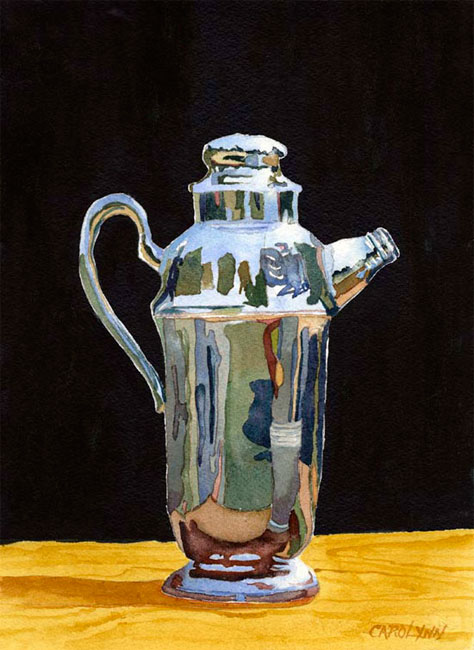
Silver Pitcher watercolour painting |
You may be interested to know that artists from every state in the USA, every province in Canada, and at least 115 countries worldwide have visited these pages since January 1, 2013.
That includes Cassandra James who asked, “What is a Zemie?”
(RG note) Thanks, Cassandra. The chiefs of the Taino had spiritual guides called zemies that helped them make wise decisions. These zemies took the form of small statues or sculptures that were brought into the caves and are still sometimes found there.
And also Stewart Turcotte of Kelowna, BC, Canada who wrote. “I’m impressed with your research into alternate paints. I know some artists in Canada use tar from Fort MacMurray for black, berry juice for purple, ox blood for red, etc., but now bat droppings for, what colour was that? No shit! We should soon have a full spectrum for environmentally friendly art.”
And also Jeanine Fondacaro who wrote, “I am on a first name basis with all my quirky ways of thinking and doing things. It’s too bad that most children aren’t given the power to embrace their uniqueness at an early age. I hope the world is changing — not every kid likes to play soccer.”
And also Jean Vincent who asked, “Did someone object to being called by their first name? Seeing my name on there is one of the things I love so much about getting your email. I know, of course, that you don’t know who I am, that the name is put in automatically, yet it’s so nice seeing my name at the beginning. Are there so many people who objected to being called by their first names that you had to change it to “Dear Artist” so they wouldn’t unsubscribe? I won’t unsubscribe because of this, but it’s a sad day!”
(RG note) Thanks, Jane. And thanks to everybody who wrote with similar concerns. It had nothing to do with my writing from a cave. Hackers attacked our website and letter-sending apparatus. We shut down rather than risk compromising your work on our site. We have now blocked the evil ones. We are sorry for the inconvenience and the impersonal way your letters were sent by another service. Actually, we were thrilled when so many notified us that they print out and require consistency. More than 38,000 received the last letter as “Dear Artist,” and didn’t like it one bit. There was no “hot” connectivity either. There were too many complaints to personally answer and explain everything. Thanks for your patience. Let’s hope that the Internet gremlins have been vanquished.

